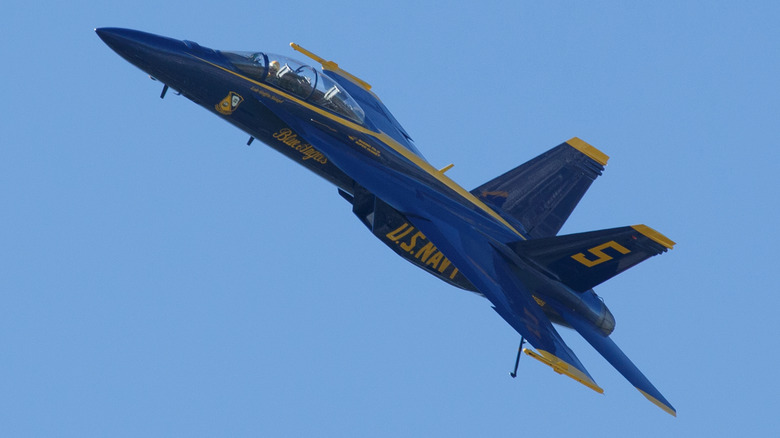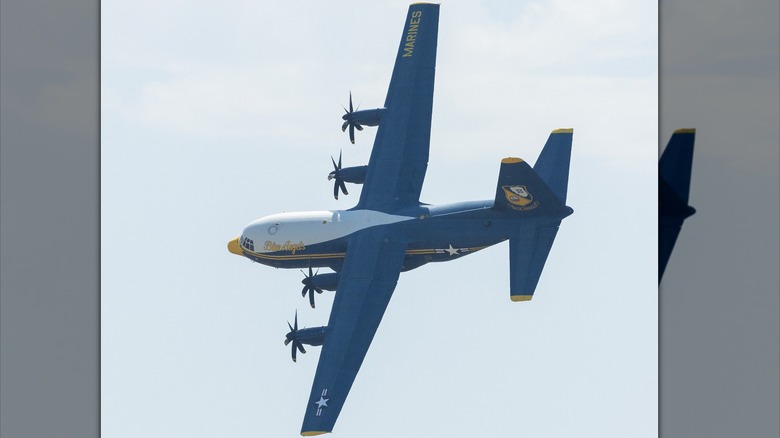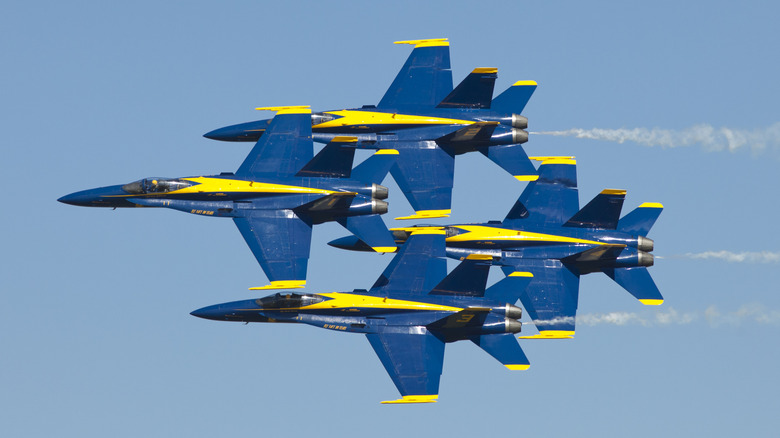How Fast Do The Blue Angels Fly? A Look At Their Top Speed
The Blue Angels have a long history of service with the U.S. Navy, having been established back in 1946. Soaring above awestruck audiences, these highly-skilled active-duty Navy and Marine aviators have flown some of the most iconic aircraft over the years. The F6 Hellcat and F-4 Phantom were just a few of the models flown by the Blue Angels in airshows past. Today, they use the F/A-18 Super Hornet, and here's how much an F-18 Super Hornet jet actually costs to build.
One thing you won't see at a Blue Angels airshow is a sonic boom, which is a phenomenon that occurs when a jet breaches the speed of sound. For those unfamiliar, here's how fast supersonic flight is and how it works.
Although, just because these pilots aren't breaking the sound barrier during demonstrations, doesn't mean they're traveling slow. In fact, the Blue Angels will reach speeds around 700 miles per hour, not because that's the F/A-18 Super Hornet's top speed, but because they aren't authorized to fly faster. This aircraft is ideal for the Blue Angels, as it can perform remarkably sharp turns, is known for its versatility and fantastic maneuvering capability. And while the F/A-18 Super Hornet isn't a member of the fifth-generation fighter jet group, it's one of several military aircraft that are way more dangerous than they look. Just consider that every Blue Angels jet is not only capable of landing on a carrier but can mobilize for combat in about 72 hours.
The Blue Angels Hornet isn't the only star of the show
Shortly after Admiral Chester Nimitz, the Chief of Naval Operations in 1946, formed the Blue Angels, it became clear the team would need to expand its fleet to include support aircraft. The Navy has employed several models over the decades, like the Douglas R4D Sky Train and the Lockheed C-121 Super Constellation. However, it wasn't until 1970 that the Lockheed Martin C-130 would come to be known by its popular nickname, "Fat Albert."
The nickname stuck, and so even though the team now uses a newer variant, the C-130J Super Hercules, it's still known as "Fat Albert." This massive aircraft can lift off the ground with up to 155,000 pounds onboard and often requires seven Marines to operate. The C-130J Super Hercules can cruise at speeds of around 400 miles per hour and features four turboprop engines that generate a staggering 4,700 horsepower each. Fortunately, those in attendance at a Blue Angels airshow get to see this huge plane in action as it performs an exciting set of maneuvers prior to the main event for around 15 minutes. Even though "Fat Albert" is absolutely massive in size, it pales in comparison to the largest jet in the U.S. military.
The role of precision and weather during an airshow
There are many draws of seeing these demonstration pilots at an airshow. The sheer power and capability of these aircraft, the roar of their engines, and the incredible acrobatics on display make for an unforgettable experience. Blue Angel pilots will go as high as 15,000 feet in the air during a vertical roll and fly at dangerously low altitudes, such as a pass done at just 50 feet. However, in one of the team's most daring stunts, the four jets slip into a diamond formation, which has them as close together as 18 inches.
Due to these risky maneuvers, good weather conditions are paramount. For example, the Blue Angels need a minimum of 3 nautical miles visibility, and the lowest layer of clouds must not be below 1,500 feet. Even though the Blue Angels can perform stunts under these circumstances, it does require them to scale back the show a bit, as the full list of acrobatics needs a minimum ceiling of 8,000 feet.
As you can imagine, becoming a pilot with the Blue Angels isn't easy, as the Navy carefully evaluates each applicant and, once onboard, considers each member of the team an ambassador of the U.S. military. If you happen to have the flying chops to make it onto the team, don't expect extra pay, as the prize is the achievement of serving with the Blue Angels and enduring a highly competitive selection process.


